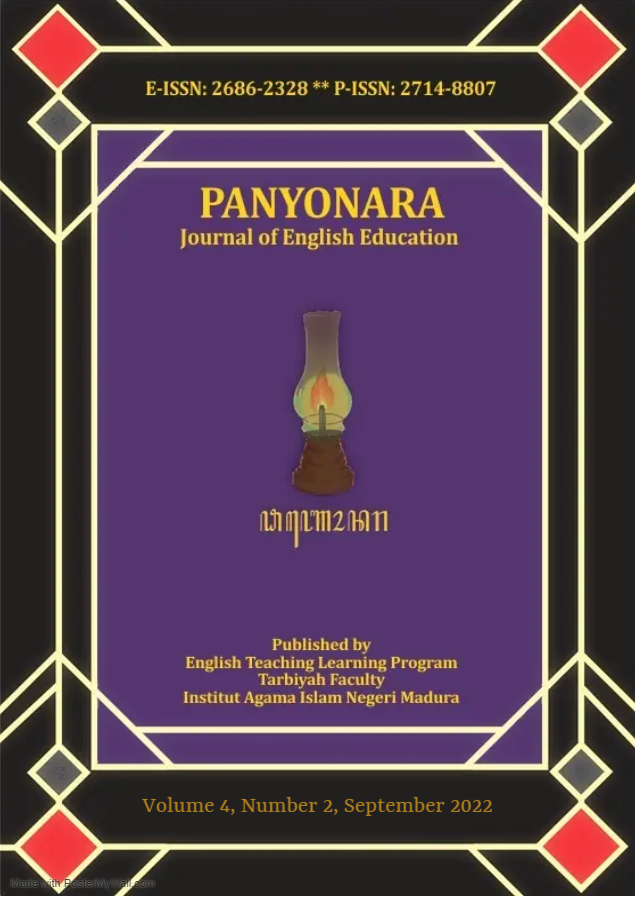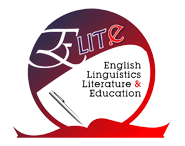A Result and Discussion of the Dynamic Assessment Approach in Language Teaching: A Literature Review Study
 Abstract views: 440
,
Abstract views: 440
,
 PDF downloads: 337
PDF downloads: 337
Abstract
Dynamic assessment is conceptually based on the sociocultural theory of Lev Vygotsky in the Zone Proximal Development. This paper aimed to discuss dynamic assessment in assessing students` reading comprehension. The limitation of this article will only discuss the definition of dynamic assessment, the historical framework of dynamic assessment, teacher roles in dynamic assessment, dynamic assessment in a foreign language, dynamic assessment of writing, dynamic assessment of reading comprehension, and the advantages and disadvantages of dynamic assessment. Based on literature studies, the dynamic assessment approach is effective in English teaching. It can conclude that this approach can be adopted and developed by English teachers to encourage students` motivation and participation in learning English.
Downloads
References
Adam, N. F. M., Rusli, N. F. M., Salleh, N. S., Mokhtar, W. K. W., Abdullah, S., & Handrianto, C. (2022). Kensiu Language Preservation: An Analysis Based on the Typological Framework of Language Threats. 15(1), 2640–2659.
Ajideh, P., & Nourdad, N. (2012). The Immediate and Delayed Effect of Dynamic Assessment on EFL Reading Ability. 12(5), 141–151.
Anton, M. (2009). Anton, M. (2009). Dynamic assessment of advanced second language learners. , 42(3), 576-598. 42(3), 576–598.
Antón, M. (2009). Dynamic Assessment of Advanced Second Language Learners. 42(3), 576–598.
Arafani, A., Handrianto, C., Ucar, A. S., & Karneli, Y. (2021). Disputing Irrational Belief in Adolescent Using Cognitive Simulation: A Case Study. 9(2), 230–236. doi: https://doi.org/10.24036/spektrumpls.v9i2.112598
Banseng, S., Sandai, R., & Handrianto, C. (2021). Language of Strata and Expression in the Construction of Sampi amongst Iban Community in Malaysia. 4(3), 417–427. doi: https://doi.org/10.5281/zenodo.5169017
Birjandi, P., & Ebadi, S. (2009). Issues in Dynamic Assessment. 2(4), 188–198.
Budoff, M., & Friedman, M. (1964). “Learning Potential” as An Assessment Approach to the Adolescent Mentally Retarded. 28(5), 434–439. doi: https://doi.org/10.1037/h0040631
Cameron, L. (2001). Teaching Languages to Young Learners. New York: Cambridge University Press.
Campione, J. C. (1989). Assisted Assessment: A Taxonomy of Approaches and an Outline of Strengths and Weaknesses. 22, 151–165.
Carlson, J. S., & Wiedl, K. H. (1992a). Principles of Dynamic Assessment: The Application of a Specific Model. 4(2), 153–166.
Carlson, J. S., & Wiedl, K. H. (1992b). The dynamic assessment of intelligence. In Interactive Assessment (pp. 167–186). New York: Springer-Verlag.
Douglas, D. (2014). Understanding Language Testing. New York: Routledge.
Fatemipour, H., & Jafari, F. (2015). The Effect of Dynamic-Assessment on the Development of Passive Vocabulary of Intermediate EFL Learners. 5(1), 41–51.
Feuerstein, R., Falik, L., Rand, Y., & Feuerstein, R. S. (2006). Creating and Enhancing Cognitive Modifiability: The Feuerstein Instrumental Enrichment Program. Jerussalem: ICELP Press.
Feuerstein, R., Feuerstein, R. S., Falik, L., & Rand, Y. (2002). The Dynamic Assessment of Cognitive Modifiability. Jerusalem: ICELP Press.
Guthke, J., & Wingenfeld, S. (1992). The Learning Test Concept: Origins, State of the Art, and Trends. In Interactive Assessment (pp. 64–93). New York: Springer-Verlag.
Habibullah, M. (2012). Techniques in Teaching Reading Comprehension. 6(2), 221–228.
Habibullah, M., Baidawi, A., Fadilah, F., & W.S. Alim. (2020). Pendampingan Pembelajaran Bahasa Inggris Bagi Murid Melalui Metode Cerita Legend of Madura di Madrasah Tsanawiyah Miftahul Ulum Gunung Tangis Desa Rek-Kerrek Kecamatan Palengaan. 2(2), 87–94.
Hafnidar, H., Harniati, I., Hailemariam, M., & Handrianto, C. (2021). Hafnidar, H., Harniati, I., Hailemariam, M., & Handrianto, C. (2021). Students self-regulation: An analysis of exploratory factors of self-regulation scale. 9(2), 220–225. doi: https://doi.org/10.24036/spektrumpls.v9i2.112589
Handrianto, C., & Rahman, M. A. (2018). Project Based Learning: A Review of Literature on Its Outcomes and Implementation Issues. 8(2), 110–129. doi: http://dx.doi.org/10.18592/let.v8i2.2394
Handrianto, C., Salleh, S. M., & Chedi, J. M. (2020). The correlation between teaching learning quality and students` motivation to study in Yogyakarta`s bimbel. (PLS), 8(4), 527-537. 8(4), 527–537. doi: https://doi.org/10.24036/spektrumpls.v8i4.110158
Haywood, H. C. (1993). A Mediational Teaching Style. 3(1), 27–38.
Haywood, H. C., & Lidz, C. (2006). Dynamic Assessment in Practice Clinical and Educational Applications. New York: Cambridge University Press.
Herwanis, D., Irham, I., & Handrianto, C. (2021). Religious Commitment Inventory-10: On Comparison Result between Minangkabau Nomad Traders and Java Transmigrants. 9(2), 95–101. doi: https://doi.org/10.24036/kolokium-pls.v9i2.484
Hizriani, N., Khairatunnisa, K., & Handrianto, C. (2022). Online and Offline Students’ Presentation in Thesis Proposal: Challenges and Solution. 3(3), 549–560. doi: https://doi.org/10.47175/rissj.v3i3.501
Ibrahim, R., Hock, K. E., Handrianto, C., Rahman, M. A., & Dagdag, J. (2021). Perceptions of Parents and Teachers on Students with Learning Disabilities (SLD) in Malaysia. 4(2), 287–298. doi: https://doi.org/10.5281/zenodo.5057585
Jarrahzadeh, Z., & Tabatabaei, O. (2014). , Z. and , O. (2014). Gender-based Study of Learners’ Reading Ability Through Dynamic Assessment (DA): Guthke’s Lerntest approach in focus. 2(7), pp. 47-53. 2(7), 47–53.
Jarrahzadeh, Z., & Tabatabaei,O. (2014). Jarrahzadeh, Z. and Tabatabaei, O. (2014). Promoting EFL Learners’ Reading Comprehension Skills through Dynamic Assessment Using Guthke’s Lerntest Approach. 3(5), 32–39.
Kozulin, A., & Garb, E. (2002). Dynamic Assessment of EFL Text Comprehension. , 23(1), pp. 112-127. 23(1), 112–127.
Lantolf, J. P. (2000). Introducing Sociocultural Theory. In Sociocultural Theory and Second Language Learning. Oxford: Oxford University Press.
Lantolf, J. P., & Poehner, M. E. (2004). Dynamic Assessment: Bringing the Past into the Future. Language Teaching42. 42, 355–368.
Lantolf, J. P., & Poehner, M. E. (2010). Dynamic Assessment in the Classroom: Vygotskian Praxis for Second Language Development. 15(1), 11–33.
Lantolf, J. P., & Thorne, S. L. (2007). Sociocultural Theory and Second Language Learning. In Theories in Second Language Acquisition (pp. 201–224). Mahwah, NJ.: Lawrence Erlbaum.
Lidz, C. (1987). Dynamic Assessment: An Interactional Approach for Evaluating Learning Potential. New York: Guilford Press.
Losardo, A., & Notari-Syverson, A. (2001). Alternative Approaches to Assessing Young Children. USA: Paul H. Brookes Publishing Co.
Lussier, C. M., & Swanson, H. L. (2005). Dynamic Assessment: A Selective Synthesis of the Experimental Literature. In Learning Potential Assessment and Cognitive Training: Actual Research and Perspectives in Theory Building and Methodology (pp. 65–87). New York: Elsevier.
Mahdavi, M. (2014). The Effect of Dynamic Assessment on Essay Writing Ability of Iranian EFL Learners: A Gender Related Study (Thesis). Eastern Mediterranean University, North Cyprus.
Mehri, E., & American, M. (2015). Challenges to Dynamic Assessment in Second Language Learning. 5(7), 1458–1466.
Murphy, R. (2011). Dynamic Assessment: Intelligence, and Measurement. UK: Wiley-Blackwell.
Musta’in, M., & Handrianto, C. (2020). Peranan Pengurusan Sekolah Berasrama Islam Nurul Hakim untuk Membangunkan Sumber Manusia Masyarakat Sekitar. 3(9), 114–123.
Nazari, B. (2012). Teach-to-Test Instruction of Dynamic Assessment: A Critical Review. 5(4), 56–68.
Nengsih, Y. K., Hendrianto, C., Pernantah, P. S., & Tannoubi, A. (2022). The Implementation of Interactive Learning Strategy to Formulating Learning Objectives in Package C Program. 10(2), 311–317. doi: https://doi.org/10.24036/spektrumpls.v10i2.117215
O’Malley, J. M., & Pierce, L. V. (1996). Authentic Assessment for English Language Learners: Practical Approaches for Teachers. Boston: Addison Wesley Publishing Company Incorporated.
Pernantah, P. S., Rizatunnita, R., Kusnilawati, L., & Handrianto, C. (2022). Implementasi Pembelajaran Tatap Muka (PTM) Terbatas Selama Masa Pandemi Covid-19 di SMAN 1 Kubu. 22(1), 46–52. doi: https://doi.org/10.24036/pedagogi.v22i1.1257
Poehner, Matthew E. (2007). Beyond the Test: L2 Dynamic Assessment and the Transcendence of Mediated Learning. 91(3), 323–340.
Poehner, M.E. (2008). Dynamic Assessment: A Vygotskian Approach to Understanding and Promoting Second Language Development. Berlin, Germany: Springer.
Ramadhani, D., Kenedi, A. K., Helsa, Y., Handrianto, C., & Wardana, M. R. (2021). Mapping Higher Order Thinking Skills of Prospective Primary School Teachers in Facing Society 5.0. 8(2), 178–190. doi: http://dx.doi.org/10.24235/al.ibtida.snj.v8i2.8794
Rita, Y., & Handrianto, C. (2021). Innovation of Digital Learning in Package C Program in Facing the New Normal Education. 9(1), 20–28. doi: https://doi.org/10.24036/kolokium-pls.v9i1.447
Sadeghi, K., & Khanahmadi, F. (2011). Dynamic assessment of L2 grammar of Iranian EFL learners: The role of mediated learning experience. 3(2), 931–935.
Salamah, U., Rumadan, I., Handrianto, C., & Alfurqan, A. (2022). The Role of Mediation Agencies in Divorce Cases as an Effort to Provide Protection against Women and Children. 14(1), 45–56. doi: https://doi.org/10.28918/muwazah.v14i1.5338
Sarte, N. M. R., Santiago, B. T., Dagdag, J. D., & Handrianto, C. (2021). Welcome Back: The Return of College Dropouts to School. 8(2), 140–149. doi: https://doi.org/10.36706/jppm.v8i2.15386
Shabani, K. (2011). Assessment of L2 Learners’ Reading Comprehension Processes: A Vygotskian Perspective. 32, 321–328.
Shrestha, P., & Coffin, C. (2012). Dynamic Assessment, Tutor Mediation and Academic Writing Development. 17(1), 55–70.
Sternberg, R. J., & Grigorenko, E. L. (2002). Dynamic Testing: The Nature and Measurement of Learning Potential. Cambridge: Cambridge University Press.
Swanson, H. L., & Howard, C. B. (2005). Children with Reading Disabilities: Does Dynamic Assessment Help in the Classification? 28, 17–34.
Tabatabaei, S., & Bakhtiarvand, M. (2014). Application of Dynamic Assessment in Second and Foreign Language Teaching. 4(3).
Tiara, A. D., Rahman, M. A., & Handrianto, C. (2021). The Students` Perception about Use of Duolingo Application for Improving English Vocabulary. 4(4), 690–701. doi: https://doi.org/10.5281/zenodo.5775915
Tzuriel, D. (2001). Dynamic Assessment of Young Children. New York: Kluwer Academic/Plenum.
Utami, D., Prihantoro, P., Apriani, E., Hidayah, J., & Handrianto, C. (2021). , D. M. A., Prihantoro, P., Apriani, E., Hidayah, J., & Handrianto, C. (2021). Empowering ICT potentials in English language teaching. , 10(2), 42-48. 10(2), 42–48. doi: https://doi.org/10.30630/polingua.v10i2.180
Vygotsky, L. S. (1978). Mind in Society: The Development of Higher Psychological Processes (ed. By M. Cole, V. John-Steiner, S. Scribner & E. Superman). Cambridge: Harvard University Press.
Wiedl, K. H. (2003). Dynamic Testing: A Comprehensive Model and Current Fields of Application. 3(2), 93–119. doi: https://doi.org/10.1891/194589503787383055
Xiaoxiao, L., & Yan, L. (2010). A Case Study of Dynamic Assessment in EFL Process Writing. 33(1).
Zhang, Y. H. (2010). Zhang, Y. H. (2010). Constructing dynamic assessment mode in college English writing class. 1. 1, 46–50.
The journal uses an Open Access policy under a Creative Commons Attribution-NonCommercial 4.0 International License. Authors who publish with this journal agree to the following terms:
- Authors retain copyright and grant the journal right of first publication with the work simultaneously licensed under a Creative Commons Attribution License that allows others to share the work with an acknowledgment of the work's authorship and initial publication in this journal.
- Authors are able to enter into separate, additional contractual arrangements for the non-exclusive distribution of the journal's published version of the work (e.g., post it to an institutional repository or publish it in a book), with an acknowledgment of its initial publication in this journal.
- Authors are permitted and encouraged to post their work online (e.g., in institutional repositories or on their website) prior to and during the submission process, as it can lead to productive exchanges, as well as earlier and greater citation of published work.
















